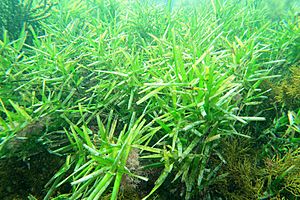Amphibolis griffithii facts for kids
Quick facts for kids Amphibolis griffithii |
|
|---|---|
 |
|
| A. griffithii in Yankalilla, Australia | |
| Conservation status | |
| Scientific classification | |
| Genus: |
Amphibolis
|
| Species: |
griffithii
|
Amphibolis griffithii is a special type of seagrass that grows in the ocean waters off the southwestern coast of Western Australia, all the way to Encounter Bay in South Australia. This seagrass forms large underwater "meadows" that are like homes for many other sea creatures. It provides food and shelter, especially in areas with strong, steady ocean currents. When parts of it break off and decay, they also create important habitats.
Meet Amphibolis griffithii: A Cool Seagrass!
This common ocean plant has rhizomes, which are like underground stems that grow horizontally. These rhizomes help the plant spread and create thick underwater meadows. These meadows are super important because they help hold the sand in place. Their tangled roots and leaves protect the seafloor from strong ocean currents.
Amphibolis griffithii is a perennial plant, meaning it lives for many years. It has separate male and female plants, and its fruits grow right on the leaves. What's really cool is how it reproduces! The seeds start to sprout while they are still attached to the parent plant. This is called viviparous reproduction. Once the tiny seedling is ready, it floats away freely. The seedling has a comb-like structure with bristles that help it anchor itself to a new spot. After it's anchored, it develops roots and rhizomes to become a fully grown plant.
The leaves of Amphibolis griffithii are found at the end of its many branches. They are bright green, sometimes with red spots, and are attached in an overlapping way. These leaves also help the seagrass meadows stay together and protect them from erosion caused by ocean currents. Each leaf can be up to 75 millimeters (about 3 inches) long and 2.5 to 6 millimeters wide. Four or five of these ribbon-like leaves grow upwards from each branch. The way its leaves and sheaths are shaped helps tell it apart from its close relative, Amphibolis antarctica. Amphibolis griffithii also tends to live in rougher ocean waters than its cousin.
Where Does This Seagrass Live?
You can find Amphibolis griffithii along the western coast of Australia, south of Geraldton, and along the southern coastlines all the way to Victor Harbor, South Australia. It's also been seen near island groups like Houtman Abrolhos and the Archipelago of the Recherche.
This seagrass loves areas with fast and constant ocean currents. Its rhizomes form thick mats on soft, sandy seabeds. It usually lives in waters less than 16 meters (about 52 feet) deep. You often find it growing near limestone or coral reef areas.
Sometimes, you'll see piles of dead Amphibolis griffithii washed up on the shoreline. These rotting piles create a rich habitat for many other plants and animals. The area where Amphibolis griffithii lives is smaller than that of Amphibolis antarctica. This might be because Amphibolis griffithii is less tolerant of different water temperatures and salt levels.
How Did It Get Its Name?
The first person to suggest a name for this species was John McConnell Black in 1948. However, the official and accepted description of the species was published by Cornelis den Hartog in 1970.


